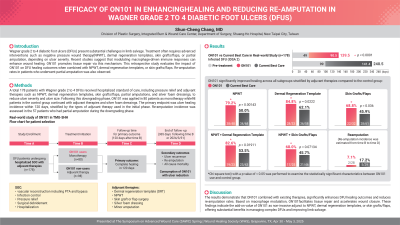Case Series/Study
(CS-028) Efficacy of ON101 in Enhancing Healing and Reducing Re-amputation in Wagner Grade 2 to 4 Diabetic Foot Ulcers (DFUs)
Friday, May 2, 2025
7:45 PM - 8:45 PM East Coast USA Time

Introduction: Wagner grade 2 to 4 diabetic foot ulcers (DFUs) present substantial challenges in limb salvage. Treatment often requires advanced interventions such as negative pressure wound therapy (NPWT), dermal regeneration templates, skin grafts/flaps, or partial amputation, depending on ulcer severity. Recent studies suggest that modulating macrophage-driven immune responses can enhance wound healing. ON101 promotes tissue repair via this mechanism. This retrospective study evaluates the impact of ON101 on DFU healing outcomes when combined with NPWT, dermal regeneration templates, or skin grafts/flaps. Re-amputation rates in patients who underwent partial amputation was also observed.
Methods: A total 178 patients with Wagner grade 2 to 4 DFUs received hospitalized standard of care, including pressure relief and adjuvant therapies such as NPWT, dermal regeneration templates, skin grafts/flaps, partial amputations, and silver foam dressings, to reduce ulcer severity and ulcer size. Following this downgrading phase, ON101 was applied in 80 patients as monotherapy while 98 patients in the control group continued with adjuvant therapies and silver foam dressings. The primary endpoint was ulcer healing incidence within 120 days, stratified by the types of adjuvant therapy used in the initial phase. Re-amputation incidence was assessed in the 57 patients who had partial amputation during the downgrading phase.
Results:
Among the 57 patients with prior partial amputation, re-amputation incidence was 7.1% (2/28) vs 17.2% (5/29).
Discussion: The results demonstrate that ON101 combined with existing therapies, significantly enhances DFU healing outcomes and reduces re-amputation rates. Based on macrophage modulation, ON101 facilitates tissue repair and accelerates wound closure. These findings indicate the add-on value of ON101 as non-invasive adjunct to NPWT, dermal regeneration templates, or skin grafts/flaps, offering substantial benefits in managing complex DFUs and improving limb salvage.
Methods: A total 178 patients with Wagner grade 2 to 4 DFUs received hospitalized standard of care, including pressure relief and adjuvant therapies such as NPWT, dermal regeneration templates, skin grafts/flaps, partial amputations, and silver foam dressings, to reduce ulcer severity and ulcer size. Following this downgrading phase, ON101 was applied in 80 patients as monotherapy while 98 patients in the control group continued with adjuvant therapies and silver foam dressings. The primary endpoint was ulcer healing incidence within 120 days, stratified by the types of adjuvant therapy used in the initial phase. Re-amputation incidence was assessed in the 57 patients who had partial amputation during the downgrading phase.
Results:
ON101 significantly improved healing across all subgroups stratified by adjuvant therapies compared to the control group:
- NPWT: 79.2% (38/48) vs. 50.0% (34/68), p = 0.00143.
- Dermal regeneration template: 84.8% (28/33) vs. 62.1% (36/58), p = 0.0222).
- Skin grafts/flaps: 68.8% (22/32) vs. 45.9% (28/61), p = 0.036.
- NPWT + Dermal regeneration template: 82.6% (19/23) vs. 53.5% (23/43), p = 0.01911.
- NPWT + Skin grafts/flaps:
68.0% (17/25) vs. 45.7% (21/46), p = 0.07134, showing a similar trend.
Among the 57 patients with prior partial amputation, re-amputation incidence was 7.1% (2/28) vs 17.2% (5/29).
Discussion: The results demonstrate that ON101 combined with existing therapies, significantly enhances DFU healing outcomes and reduces re-amputation rates. Based on macrophage modulation, ON101 facilitates tissue repair and accelerates wound closure. These findings indicate the add-on value of ON101 as non-invasive adjunct to NPWT, dermal regeneration templates, or skin grafts/flaps, offering substantial benefits in managing complex DFUs and improving limb salvage.

.jpg)